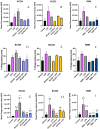Novel Fermentates Can Enhance Key Immune Responses Associated with Viral Immunity
- PMID: 38674902
- PMCID: PMC11053696
- DOI: 10.3390/nu16081212
Novel Fermentates Can Enhance Key Immune Responses Associated with Viral Immunity
Abstract
Fermented foods have long been known to have immunomodulatory capabilities, and fermentates derived from the lactic acid bacteria of dairy products can modulate the immune system. We have used skimmed milk powder to generate novel fermentates using Lb. helveticus strains SC234 and SC232 and we demonstrate here that these fermentates can enhance key immune mechanisms that are critical to the immune response to viruses. We show that our novel fermentates, SC234 and SC232, can positively impact on cytokine and chemokine secretion, nitric oxide (NO) production, cell surface marker expression, and phagocytosis in macrophage models. We demonstrate that the fermentates SC234 and SC232 increase the secretion of cytokines IL-1β, IL-6, TNF-α, IL-27, and IL-10; promote an M1 pro-inflammatory phenotype for viral immunity via NO induction; decrease chemokine expression of Monocyte Chemoattractant Protein (MCP); increase cell surface marker expression; and enhance phagocytosis in comparison to their starting material. These data suggest that these novel fermentates have potential as novel functional food ingredients for the treatment, management, and control of viral infection.
Keywords: fermentates; functional food; immune boosting; immunomodulation; macrophage; viral immunity.
Conflict of interest statement
Authors Monica A. Mechoud, Tom Beresford, Harsh Mathur, Paul D. Cotter were employed by the company Teagasc. The remaining authors declare that the research was conducted in the absence of any commercial or financial relationships that could be construed as a potential conflict of interest.
Figures






Similar articles
-
Novel Dairy Fermentates Have Differential Effects on Key Immune Responses Associated with Viral Immunity and Inflammation in Dendritic Cells.Foods. 2024 Jul 29;13(15):2392. doi: 10.3390/foods13152392. Foods. 2024. PMID: 39123583 Free PMC article.
-
Characterization of immune-active peptides obtained from milk fermented by Lactobacillus helveticus.J Dairy Res. 2010 May;77(2):129-36. doi: 10.1017/S002202990999046X. Epub 2010 Jan 18. J Dairy Res. 2010. PMID: 20078905
-
Mesenchymal stem cells alter macrophage immune responses to Leishmania major infection in both susceptible and resistance mice.Immunol Lett. 2016 Feb;170:15-26. doi: 10.1016/j.imlet.2015.12.002. Epub 2015 Dec 15. Immunol Lett. 2016. PMID: 26703818
-
Health Benefits of Lactic Acid Bacteria (LAB) Fermentates.Nutrients. 2020 Jun 4;12(6):1679. doi: 10.3390/nu12061679. Nutrients. 2020. PMID: 32512787 Free PMC article. Review.
-
Targeted Application of Functional Foods as Immune Fitness Boosters in the Defense against Viral Infection.Nutrients. 2023 Jul 28;15(15):3371. doi: 10.3390/nu15153371. Nutrients. 2023. PMID: 37571308 Free PMC article. Review.
Cited by
-
Novel Dairy Fermentates Have Differential Effects on Key Immune Responses Associated with Viral Immunity and Inflammation in Dendritic Cells.Foods. 2024 Jul 29;13(15):2392. doi: 10.3390/foods13152392. Foods. 2024. PMID: 39123583 Free PMC article.
-
Using nutrition to help recovery from infections.Curr Opin Gastroenterol. 2025 Jan 1;41(1):54-58. doi: 10.1097/MOG.0000000000001068. Epub 2024 Nov 20. Curr Opin Gastroenterol. 2025. PMID: 39633586 Free PMC article. Review.
References
-
- García-Burgos M., Moreno-Fernández J., Alférez M.J., Díaz-Castro J., López-Aliaga I. New Perspectives in Fermented Dairy Products and Their Health Relevance. J. Funct. Foods. 2020;72:104059. doi: 10.1016/j.jff.2020.104059. - DOI
MeSH terms
Substances
Grants and funding
LinkOut - more resources
Full Text Sources
Miscellaneous

